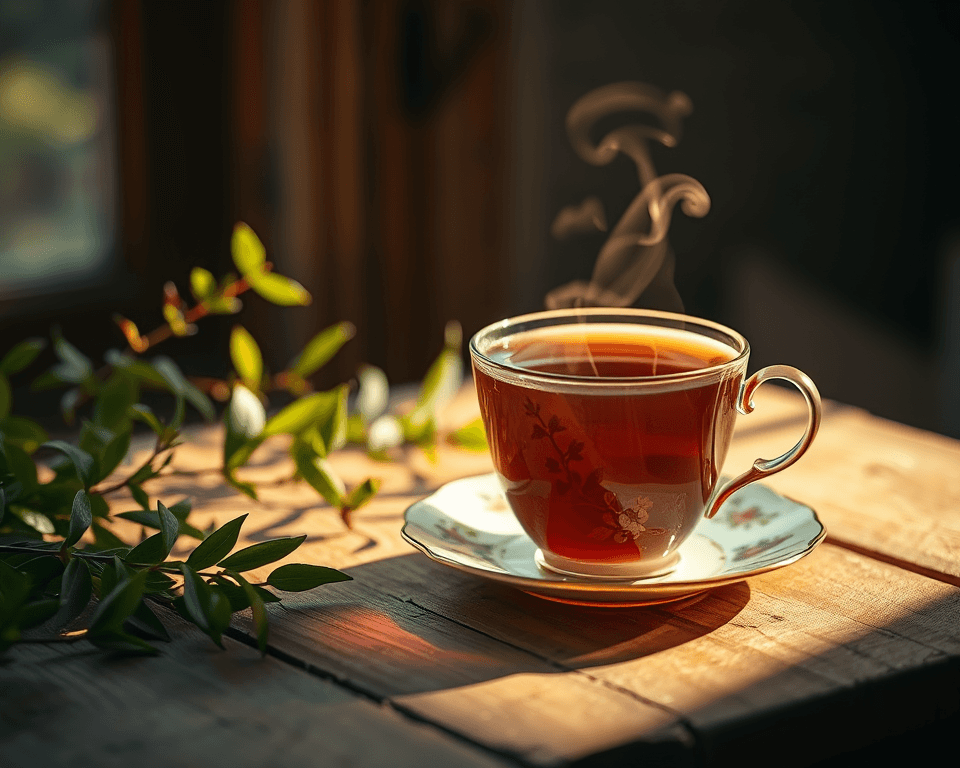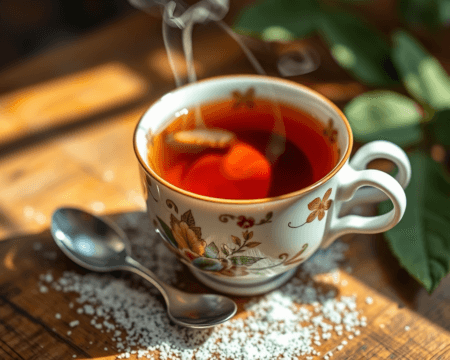Ever caught yourself wondering whether your beloved tea is actually good for your body? You’re not alone. There’s something so comforting about curling up with a warm cup of tea, but when it comes to acidity, many of us are just plain confused. Today, I’m zeroing in on Rooibos tea, that delightful South African treasure. Is it acidic? Should it be a part of your health regime? Let’s break it down, and trust me, by the end of this, you’ll have clarity and actionable insights.
Key Takeaways
- Rooibos tea is naturally low in acidity, making it gentle on your stomach.
- Compared to other teas like black and green, Rooibos shines with its non-acidic profile.
- It’s packed with antioxidants and offers a slew of health benefits despite its acidity.
- If you’re sensitive to acid, Rooibos can be a fantastic alternative to traditional teas.
What is Rooibos Tea and Its Acidity Level?
Defining Rooibos Tea
Rooibos tea, also known as red tea, comes from the Aspalathus linearis plant. Originating in South Africa, it’s become beloved worldwide, especially for its caffeine-free nature. If you’re swapping out your regular tea for something a little less jittery, Rooibos is your answer. It’s herbal, it’s refreshing, and let’s be real—it’s a fun conversation starter!
The preparation methods of Rooibos make it unique. Whether you’re steeping it traditionally or trying out a trendy Rooibos latte, the versatility is crazy impressive. No wonder it’s made its way into kitchens and cafes across the globe.
Is Rooibos Tea Acidic?
Now, here’s where it gets fascinating. You might be surprised to learn that Rooibos tea generally has a low pH level, sitting comfortably around 6.0 to 6.5. For context, most traditional teas like black tea range from 4.9 to 5.5. This means Rooibos offers a non-acidic tea experience—a relief for those of us with sensitive stomachs.
Let me share a quick side note: many people shy away from tea because of its acidity. But with Rooibos, you can enjoy your tea ritual without fretting about acid reflux or heartburn—the ultimate win! Studies have shown that maintaining a lower acid content is beneficial for those managing digestion issues or sipping tea on an empty stomach.
Comparison of Rooibos Tea’s Acidity with Other Common Teas
Acidity Levels of Different Tea Types
When we start stacking Rooibos against the tea giants—black tea, green tea, and herbal variations like chamomile—it’s illuminating. Here’s a quick rundown of how they stack up:
| Tea Type | pH Level (approx.) |
|---|---|
| Rooibos Tea | 6.0 – 6.5 |
| Black Tea | 4.9 – 5.5 |
| Green Tea | 7.0 (neutral) |
| Chamomile Tea | 6.0 – 6.2 |
Rooibos’ stature as a low-acid tea variety means it can be a game-changer for tea enthusiasts who experience discomfort with traditional options. It beautifully balances a flavor that’s both sweet and earthy without the harsh aftertaste that can come with more acidic teas.
Implications of Acidity on Taste and Health
Let’s talk flavors. The unique taste of Rooibos is largely due to its low acidity; it won’t leave you with that lingering sour note like black tea can. Instead, you get a rich, yet smooth flavor profile. In terms of health impacts, this can’t be overstated. Consuming low-acid beverages can improve digestive health, reducing irritation for folks with issues like gastritis or acid reflux.
Interestingly, studies reveal that a lower acidity level in beverages means you’re less likely to suffer from negative side effects related to taste and health. People have reported improved enjoyment of tea and better overall health when making the switch to Rooibos. What’s not to love there?
Potential Health Effects Related to Rooibos Tea’s Acidity
Benefits of Rooibos Tea Despite Acidity
So, what’s in it for you? Rooibos is loaded with antioxidants—yes, those magical compounds that fight free radicals. If you’re looking for ways to reduce inflammation and support heart health, Rooibos has got your back. The polyphenols in this tea aren’t just hot air. They contribute to its antioxidant properties, making your morning cup a powerhouse of wellness.
The magic continues with the absence of caffeine. For anyone looking to cut back on that jittery feeling or struggling with sleep, Rooibos is a smooth operator. Seriously, you can sip this stuff morning, noon, or night without worrying about staying up past your bedtime.
Who Should Be Cautious About Acidic Beverages?
But hold up! If you’ve got a sensitive stomach or conditions like GERD, it’s wise to be cautious. Not everyone’s digestive system is built the same, and even a low-acid beverage like Rooibos might not be your best bet if your stomach is particularly sensitive. It’s always smart to listen to your body. If you find Rooibos doesn’t sit well with you, there are plenty of fun alternatives out there.
Keep in mind the dietary implications—pairing foods with low-acid beverages can improve overall digestive comfort. A soothing cup of Rooibos can make a lovely complement to your meals and snacks.
User Experiences with Rooibos Tea and Acidity
Personal Stories and Testimonials
One of the most enriching parts of enjoying Rooibos tea is hearing personal stories and testimonials. I’ve spoken to people who’ve seen remarkable improvements in their digestion by switching to this herbal tea. Imagine sipping on a cup and feeling lighter afterward! The feedback is overwhelmingly positive—less bloating, more joy in every sip.
A buddy of mine, who used to chug down black tea every afternoon, switched to Rooibos after his doctor suggested it for his stomach woes. He’s raved about the taste and how it made his gut feel like a million bucks—it’s like hitting the jackpot for tea lovers.
Influence of Rooibos Tea on Digestion
The soothing effect of Rooibos on digestion is like a warm hug for your stomach. Many people experience a significant reduction in gut discomfort after making the switch. The tea’s anti-inflammatory properties can help soothe an upset stomach. So, not only do you get to enjoy a delicious beverage, but you’re nurturing your well-being, too!
Traditional uses often highlight how Rooibos was used to relieve discomfort for generations in South Africa. It’s no surprise that this herbal remedy has found its way into modern health routines. With more research pouring in, the reputation of Rooibos as a tea remedy will only continue to grow.
Tips on Enjoying Rooibos Tea for Those Concerned About Acidity
Best Brewing Practices for Reduced Acidity
If you’re keen on maximizing the benefits of Rooibos while keeping its soothing nature at its peak, consider your brewing practices. Steep it at a lower temperature, around 195°F to 205°F, and keep your steeping time to about 5–7 minutes max. This way, you’ll get all the flavors without extracting excessive bitterness or unwanted acidity.
Experimenting with the infusion method can also lead to some exciting results. By adjusting the temperature and steeping time, you can enhance the flavor while keeping it smooth and gentle on your digestive system.
Recipes Incorporating Rooibos Tea
And why stop at sipping? Rooibos tea makes for an incredible ingredient in various recipes. Ever tried a Rooibos tea smoothie? Just blend some cold Rooibos tea with banana, spinach, and almond milk. It’s refreshing and nutrient-packed! Want to cool off in summer? How about a Rooibos iced tea, sweetened just right with honey and a splash of lemon? The culinary uses for Rooibos are endless, letting you enjoy this powerhouse in innovative and delicious ways.
Incorporating Rooibos in your cooking can kick up the flavor and offer health benefits. Try steeping it into your oats or using it as a base for sauces—you’ll be surprised at how it transforms your meals!
In summary, Rooibos tea isn’t just a delightful drink; it’s your ally in tackling acidity while reaping health rewards. With its gentle flavor, soothing properties, and culinary versatility, Rooibos is a must-try for health-conscious consumers and tea enthusiasts alike. So go ahead, brew a cup, and give your body the treat it deserves!
Frequently Asked Questions
What is Rooibos tea made from?
Rooibos tea is made from the leaves of the Aspalathus linearis plant, which is native to South Africa. It is naturally caffeine-free and has a unique, slightly sweet flavor, making it a popular alternative to traditional teas.
How does Rooibos tea compare to other herbal teas?
Unlike many herbal teas that can be acidic, Rooibos tea is naturally low in acidity, making it gentler on the stomach. Additionally, it is rich in antioxidants, setting it apart from many other herbal infusions in terms of health benefits.
Can Rooibos tea help with digestive issues?
Yes, Rooibos tea may help alleviate digestive problems due to its low acidity and antioxidant properties. Many find it soothing on the stomach, making it a suitable choice for those with sensitive digestive systems.
Is Rooibos tea safe for everyone to drink?
Rooibos tea is generally considered safe for most people, including pregnant women. However, those with specific health conditions or allergies should consult their healthcare provider before introducing new herbal teas into their diet.
How should I prepare Rooibos tea for maximum benefits?
To prepare Rooibos tea, steep 1-2 teaspoons of loose leaves or one tea bag in boiling water for about 5-7 minutes. For a richer flavor, you can brew it longer. Enjoy it plain or with honey and lemon for added taste.
Can Rooibos tea be consumed at any time of day?
Yes, Rooibos tea can be enjoyed at any time without affecting sleep, as it is caffeine-free. Whether as a morning beverage or evening relaxation drink, it’s versatile for various moments throughout the day.
Are there any side effects of drinking Rooibos tea?
Rooibos tea is safe for most individuals, but excessive consumption may lead to potential side effects. Some people might experience mild digestive issues; hence moderation is key, especially for those new to it.
Is Rooibos tea beneficial for skin health?
Rooibos tea is high in antioxidants, which can support skin health when consumed. Additionally, it is often used topically in skincare products for its soothing and anti-inflammatory properties, benefiting sensitive or irritated skin.
Where can I buy Rooibos tea?
Rooibos tea can be purchased at health food stores, specialty tea shops, and online retailers. Look for certified organic varieties to ensure quality and purity.










